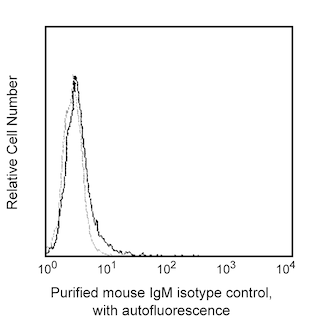-
Your selected country is
Middle East / Africa
- Change country/language
Old Browser
This page has been recently translated and is available in French now.
Looks like you're visiting us from {countryName}.
Would you like to stay on the current country site or be switched to your country?




Flow cytometric analysis of CD66b expression on human peripheral blood granulocytes. Whole blood was stained with either Purified Mouse Anti-Human CD66b (Cat. No. 555723; solid line histogram) or Purified Mouse IgM, κ Isotype Control (Cat. No. 555581; dashed line histogram), followed by FITC Goat Anti-Mouse IgG/IgM (Cat. No. 555988). Erythrocytes were lysed with BD Pharm Lyse™ Lysing Buffer (Cat. No. 555899). Fluorescent histograms depicting CD66b (or Ig isotype control) expression were derived from gated events with the side and forward light-scattering characteristics of viable granulocytes. Flow cytometry was performed on a BD FACScan™ system.


BD Pharmingen™ Purified Mouse Anti-Human CD66b

Regulatory Status Legend
Any use of products other than the permitted use without the express written authorization of Becton, Dickinson and Company is strictly prohibited.
Preparation And Storage
Product Notices
- Since applications vary, each investigator should titrate the reagent to obtain optimal results.
- An isotype control should be used at the same concentration as the antibody of interest.
- Caution: Sodium azide yields highly toxic hydrazoic acid under acidic conditions. Dilute azide compounds in running water before discarding to avoid accumulation of potentially explosive deposits in plumbing.
- Sodium azide is a reversible inhibitor of oxidative metabolism; therefore, antibody preparations containing this preservative agent must not be used in cell cultures nor injected into animals. Sodium azide may be removed by washing stained cells or plate-bound antibody or dialyzing soluble antibody in sodium azide-free buffer. Since endotoxin may also affect the results of functional studies, we recommend the NA/LE (No Azide/Low Endotoxin) antibody format, if available, for in vitro and in vivo use.
- Please refer to http://regdocs.bd.com to access safety data sheets (SDS).
- Please refer to www.bdbiosciences.com/us/s/resources for technical protocols.
Companion Products

.png?imwidth=320)
The G10F5 monoclonal antibody specifically binds to CD66b, also known as Carcinoembryonic antigen-related cell adhesion molecule 8 (CEACAM8). CD66b is a glycosylphosphatidylinositol (GPI) linked protein with a molecular weight of 100 kDa expressed on granulocytes. This molecule was previously clustered as CD67 in the Fourth Human Leucocyte Differentiation Antigen (HLDA) Workshop and renamed CD66b in the Fifth HLDA Workshop. CD66b is a member of the carcinoembryonic antigen (CEA)-like glycoprotein family present on granulocytes and referred to as non-specific crossreacting antigens (NCA). Granulocyte activation induced with soluble stimulators (calcium ionophore, phorbol myristate acetate, N-formylmethionyl- leucyl-phenylalanine) results in release and increased expression of NCA. Findings suggest that these molecules may play a role in phagocytosis, chemotaxis and adherence.
Development References (5)
-
Knapp W. W. Knapp .. et al., ed. Leucocyte typing IV : white cell differentiation antigens. Oxford New York: Oxford University Press; 1989:1-1182.
-
Kuijpers TW, van der Schoot CE, Hoogerwerf M, Roos D. Cross-linking of the carcinoembryonic antigen-like glycoproteins CD66 and CD67 induces neutrophil aggregation. J Immunol. 1993; 151(9):4934-4940. (Biology). View Reference
-
Kuroki M, Matsuo Y, Kinugasa T, Matsuoka Y. Augmented expression and release of nonspecific cross-reacting antigens (NCAs), members of the CEA family, by human neutrophils during cell activation. J Leukoc Biol. 1992; 52(5):551-557. (Biology). View Reference
-
Lund-Johansen F, Olweus J, Horejsi V, et al. Activation of human phagocytes through carbohydrate antigens (CD15, sialyl-CD15, CDw17, and CDw65).. J Immunol. 1992; 148(10):3221-9. (Biology). View Reference
-
Schlossman SF. Stuart F. Schlossman .. et al., ed. Leucocyte typing V : white cell differentiation antigens : proceedings of the fifth international workshop and conference held in Boston, USA, 3-7 November, 1993. Oxford: Oxford University Press; 1995.
Please refer to Support Documents for Quality Certificates
Global - Refer to manufacturer's instructions for use and related User Manuals and Technical data sheets before using this products as described
Comparisons, where applicable, are made against older BD Technology, manual methods or are general performance claims. Comparisons are not made against non-BD technologies, unless otherwise noted.
For Research Use Only. Not for use in diagnostic or therapeutic procedures.
Report a Site Issue
This form is intended to help us improve our website experience. For other support, please visit our Contact Us page.